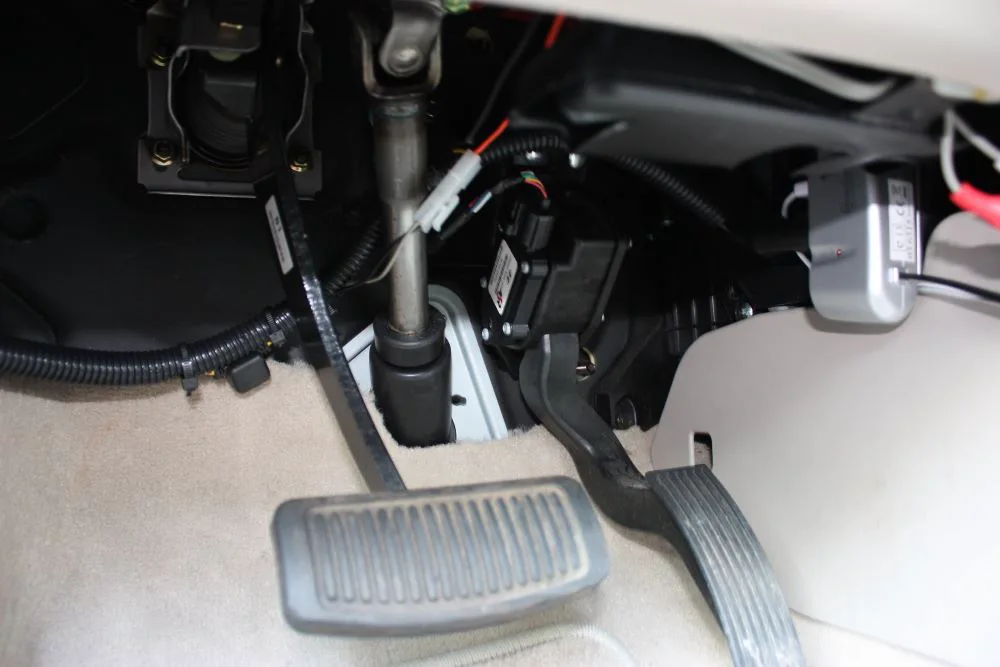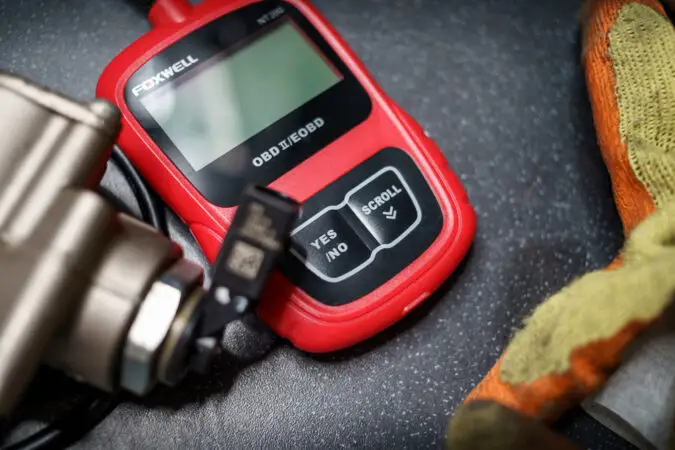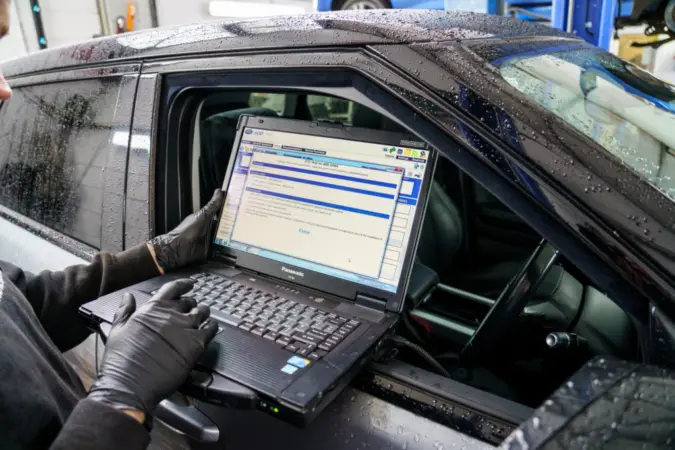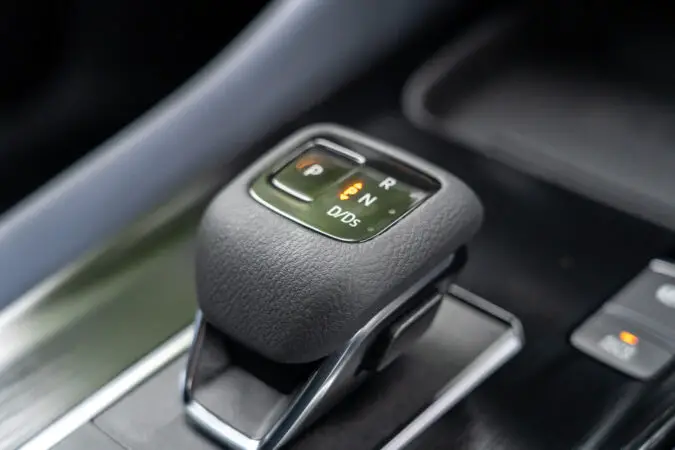Are you feeling a lack of response from the accelerator pedal as well as the check engine light? In this case, you might be struggling with a bad accelerator pedal position sensor. If you suspect that, then you are at the right place because there will be a lot to cover on this topic.
- How To Diagnose Car Problems?
- Gas/Throttle/Accelerator Pedal Sensor
- 6 Pin Connector
- Throttle Pedal Sensor Problems
- OBD-II Trouble Diagnostic Codes
- Symptoms Of A Bad Sensor
- Diagnosing The Pedal Sensor
- Repair And Replacement Costs
- Final Conclusion
- Frequently Asked Questions (FAQs)
Having a problem like this can be a really frustrating thing to deal with because not only that you could feel some lack of response. But you could also feel some power surges that can get really dangerous and close to the edge. You can rear-end someone or possibly hit a pedestrian in some situations. That’s why you need to focus on fixing this problem.
This is why you need to understand how car diagnostics work and learn how to troubleshoot things on your car. Because if you don’t do it, someone will do it for you and you will pay a ton of money for something simple like in this case. But you shouldn’t worry because we are going to help you out.
First, we will dive into the basics of car diagnostics and cover some of the basic things you should know, then we will cover the accelerator pedal position sensor. We will learn everything about it, the diagram, the trouble codes, and the symptoms that are associated with this sensor. Then we will cover the testing and troubleshooting process as well as the replacement and you don’t want to miss that.
Introduction To Car Diagnostics
Now before we dive into the accelerator pedal position sensor problems, let’s first focus more on the basics of car diagnostics. If you think that you can handle this without a good introduction, you can jump to one of the following chapters. If not, keep up with us for a bit.
As you probably know modern cars include a ton of technology in them. They are packed with sensors and other equipment that make them a real pain to diagnose.
So, when you have a problem with the accelerator pedal position sensor. It is highly likely that you will get a check engine light. This is the case because this sensor is connected to the PCM or ECM as some call it. This is the car computer, the brain of all operations in your vehicle. Without it, you will not be able to run the car.
Nevertheless, what is important for you is that this PCM is recording the work of all of the different sensors in the car. So, whenever you have something malfunctioning, it will record codes on this component.
This is why you need to have an OBD2 scanner tool. With this tool, you will be able to diagnose any problem with your car. Just plug it in the OBD2 port and let it scan. Then wait for the accelerator pedal position sensor code. And that we are going to cover in a bit after we cover the basics of the accelerator pedal position sensor.
Accelerator Pedal Position Sensor
Now as we covered the basics of car diagnostics, let’s now move on and focus more on this sensor, which in our case is the accelerator pedal position sensor. What this sensor is and why it is so important?
Well, this APP sensor basically measures the throttle that you apply with your foot. This sensor is located on top of the gas pedal, or on the firewall and basically follows the movement of the pedal and then applies gas to the engine. So, you can understand why it is so important.
In the past, everything was regulated with a metal wire. Nowadays, everything is drive-by-wire. So, the philosophy has changed.
This new design with a sensor might be more convenient and cheaper. But it can fail more often than the good old-fashioned metal wire that was connected to the throttle.
This APP sensor as we said is tracking the movement of the pedal and then sends this signal to the PCM. So, based on this input, the computer is adjusting the throttle response and the air to fuel mixture in the car. Achieving a smoother power delivery to the wheels.
But have you asked how this accelerator pedal position sensor functions under the hood? Let’s elaborate more on that in the following chapter before we dive into the accelerator pedal position sensor problems.
6 Pin Accelerator Pedal Position Sensor Wiring Diagram
As we covered the basics of the accelerator pedal position sensor and learned what this sensor does behind the curtain. We can now focus more on the technical aspect of this sensor. Namely, the 6-pin accelerator pedal position sensor wiring diagram. How this sensor is wired?
Knowing this will be extra useful for you as a beginner to know how to troubleshoot the connector as well as the sensor with a multimeter tool. Now let’s elaborate on it.
As the name implies, this sensor is a 6-pin sensor. This means that it has a total of 6 pins or 6 wires that go into the harness. So, the connector for this sensor has a pin for each of these wires.
They have 6 pins because in most cases, these sensors are dual. Meaning that it has two of them. So, when one of these units fails, you will not face a complete failure of the throttle.
So, whenever you are dealing with a 6-pin connector, means that you have two actual sensors.
There are two signal wires that go to the PCM, these are usually the middle connectors. Then there are two power wires 5 volts each and there are two ground wires.
Overall, that’s all that you need to know when it comes to the 6-pin accelerator pedal position sensor. Now let’s move on to the problems that are associated with this APP sensor on your car.
Accelerator Pedal Position Sensor Problems
Now cover the accelerator pedal position sensor problems. What type of problems this sensor can cause you as a car owner?
Well, as we mentioned previously, this sensor is a double sensor. This means that there are two separate sensors in this component. So, why is this the case?
Well, this is the case because you don’t want a complete failure. Especially not when you have a crucial component like the throttle. This way you are secure. You might be experiencing some symptoms that we are going to cover later on. But still, complete control over the throttle will be kept.
When it comes to accelerator pedal position sensor problems, your main concern will be the check engine light and in the next chapter, we are going to cover all of the codes that are associated with this component when it malfunctions.
What is important for you is not to panic and don’t get overwhelmed by the information that we are giving you. Read the article a couple of times to understand all the important bits. Next, we will cover the codes that you will experience when this APP sensor is bad.
Accelerator Pedal Position Sensor Code
In this chapter, as we hinted previously we are going to discuss the accelerator pedal position sensor code. What codes can you expect to get when you are experiencing issues with the APPS sensor? Let’s elaborate.
When this sensor is bad there could be a ton of codes that can relate to this component. But the most frequent are the ones that relate to the electrical circuit of this sensor and indicate low or high voltage in the circuit.
All of the time when this sensor is working, there should be an ideal voltage in the circuit. Remember that. Anything above or below is a potential failure and a clear sign that you need to replace this sensor. So, what are the codes? Let’s elaborate on them.
The first two are P2122 and P2123. The first one which is the P2122 definition is “Accelerator Pedal Position Sensor A Circuit Low Voltage”. The P2123 is basically the same for the A sensor but indicates a high voltage in the circuit.
The second two codes are P2127 and P2128. The first P2127 definition is “Accelerator Pedal Position Sensor B Circuit Low Voltage”. While the latter one P2128 indicates a high voltage in the circuit of sensor B.
Overall, these are the most frequent codes. But this doesn’t mean that this will be the same in your case. Accelerator pedal position sensor code sometimes depends much on the manufacturer of the car. Now let’s jump into the symptoms of a bad APP sensor.
Throttle Position Sensor Symptoms
As we cleared the problem with the bad accelerator pedal position sensor as well as the diagram and other important bits concerning this component, now we can start discussing the bad accelerator pedal position sensor symptoms.
As we already told you, complete failure of this sensor is not possible. Mainly because there are two sensors in the same housing. So, when one fails, the other sensor can keep working. And what happens is that some owners keep ignoring the issue and the other sensor fails as well. And this is not good. That’s why we need to cover the symptoms when this component fails completely. Now let’s begin.
Symptoms #1. Check Engine Light
The first in our list of bad accelerator pedal position sensor symptoms and the most important symptom for you is the check engine light.
This light doesn’t tell a lot. But still, it tells you that you are having a problem with your car. This problem can be anything. But it’s up to you to put up your sleeves and jump into diagnosing the problem. If you catch the problem on time, you will possibly avoid a complete failure of this sensor.
If you notice a check engine light, the first thing you will need to do is to grab an OBD2 scanner tool and let the tool do its job. Should you get any of the following codes which are: P2122, P2123, P2127, or P2128, you know that you are having a problem with this sensor and this problem needs to be sorted out as soon as possible.
There could also be other codes, greatly depending on the make and model of your vehicle. That’s why you need to do good research on your make and model plus the problem with this APP sensor. You will probably get a ton of sources if you own a relatively mainstream vehicle like a Chevy or a Toyota. Now let’s dive into the other symptoms in the case when this sensor fails completely.
Symptoms #2. Rough Idle
The second in our list of bad accelerator pedal position sensor symptoms is the rough engine idle. So, why is this the case?
Well, this will be the case because the PCM will not be able to record the right voltage that the sensor is producing. It could be lower than 1 volt or higher than that.
So, when the PCM records higher voltage because your sensor has malfunctioned, you can expect a rough idle. The same situation as someone is pressing the gas pedal for you.
Not an ideal situation because this can get really dangerous because you can hit someone in front of you. That’s why you should not ignore abnormal situations like this.
Symptoms #3. Delay After You Press On The Throttle
The third symptom in our list of bad accelerator pedal position sensor symptoms is the delay after you press the pedal.
If there is a problem with this sensor, you can expect some poor work of the gas pedal and delayed action.
This is also a dangerous situation that you really want to avoid. Namely, because the car will not get on the gas, and when you floor it, it will surge forward and you could possibly hit something that is in front of you. Damaging the car in the process or hurting someone.
So, these abnormalities should not be ignored and should be sorted out accordingly before they become worse and worse. A clear indication that you have a problem with the gas pedal and you are suffering from some kind of malfunction of the accelerator pedal position sensor.
Symptoms #4. Car Does Not Accelerate When Gas Pedal Is Pressed
The fourth symptom in our list of bad accelerator pedal position sensor symptoms is the situation when the car simply doesn’t respond.
This is the situation when the sensor is completely dead and not reacting to anything that you throw at it. The gas pedal is simply dead and it doesn’t matter what you do, you will have an unresponsive car.
So, whenever this is the case, you better tow the car to the nearest shop and let the mechanics deal with the problem as soon as possible and you regain control of your vehicle’s throttle.
Or do a scan by yourself. And if you deem the sensor to be faulty, just replace it with a new unit. Now let’s move on to the last probable symptom when you have a problem like this with the accelerator pedal position sensor.
Symptoms #5. Poor Shifting Of The Automatic Transmission
The last in our list of bad accelerator pedal position sensor symptoms that we would like to discuss is the poor feedback from your automatic transmission and the situation when this transmission jerks or stalls possibly.
This is the case because the automatic transmission needs the input from the APP sensor and without it basically will not be able to operate the right way.
The transmission follows the throttle input and then decides if it needs to go a gear up or down. So, when there is no sensor to tell it what to do, it will start to behave erratically and will jerk quite often under these circumstances.
So, if you notice that something is happening with your transmission and doesn’t shift right, you might want to take a look at this accelerator pedal position sensor and see if it works well. But how you can tell if this sensor is bad or not? Well, that’s what we are going to cover in the following chapter where we will learn everything about this.
Symptoms #6. Unpredictable Vehicle Speeds
The sixth symptom of a bad accelerator pedal position sensor is unpredictable vehicle speeds. This sensor is responsible for sending the position of the gas pedal to the vehicle’s computer, which then controls the throttle. When this sensor fails, it may send incorrect signals, causing the vehicle speed to vary randomly. You might notice that your vehicle is suddenly accelerating or decelerating without any input from you. This situation is dangerous, as it may lead to accidents.
Symptoms #7. Decreased Fuel Efficiency
The seventh symptom of a bad accelerator pedal position sensor is decreased fuel efficiency. This sensor plays a vital role in the vehicle’s fuel management system. If it fails, the vehicle’s computer will not receive accurate information about the position of the gas pedal. As a result, the engine may use more fuel than necessary. If you notice a sudden drop in your vehicle’s fuel efficiency, it might be due to a faulty accelerator pedal position sensor.
Symptoms #8. Engine Misfire or Stalling
The eighth symptom of a bad accelerator pedal position sensor is engine misfire or stalling. If this sensor is not working correctly, the vehicle’s computer will not be able to control the throttle properly. This may lead to engine misfires or even stalling, especially at low speeds or while idling. It’s essential to address this issue immediately to avoid further damage to the engine or other components.
Symptoms #9. Trouble Starting the Vehicle
The ninth symptom of a bad accelerator pedal position sensor is trouble starting the vehicle. If this sensor fails, it may not send the correct signals to the vehicle’s computer, affecting the air-fuel mixture required for combustion. This can make it difficult to start the vehicle, especially if the sensor is sending incorrect signals that the gas pedal is depressed when it is not.
Symptoms #10. Erratic Throttle Response
The tenth symptom of a bad accelerator pedal position sensor is erratic throttle response. The vehicle’s throttle response may become slow, or it may surge suddenly, making it hard to control the vehicle. This symptom may occur while driving at a steady speed or while accelerating. It can lead to dangerous situations on the road, so it’s crucial to address this issue as soon as possible.
Symptoms #11. Illumination of the Traction Control Light
The eleventh symptom of a bad accelerator pedal position sensor is the illumination of the traction control light. The vehicle’s computer uses the signals from this sensor to control the traction control system. If the sensor fails, it may cause the traction control light to illuminate on the dashboard. This indicates that the traction control system is not working correctly, and the vehicle may lose traction, especially in slippery conditions.
Symptoms #12. Failure to Pass Emissions Test
The twelfth symptom of a bad accelerator pedal position sensor is the failure to pass an emissions test. This sensor plays a crucial role in controlling the vehicle’s emissions. If it fails, the vehicle may produce higher levels of pollutants, leading to a failure in the emissions test.
In conclusion, the accelerator pedal position sensor is a crucial component of your vehicle. It helps control the throttle, fuel efficiency, and emissions. If you experience any of the symptoms mentioned above, it’s essential to get your vehicle inspected by a professional as soon as possible. Ignoring these symptoms can lead to more severe problems and costly repairs in the future.
Accelerator Pedal Position Sensor Testing
Now we have come to the important bit. And that is the accelerator pedal position sensor testing. So, what you will need in this situation?
The first tool you will need is an OBD2 scanner tool. With this tool, you will be able to scan the car and determine which of the sensors is bad, and based on these codes look for your solution.
The second thing you will need is a multimeter tool. With this tool, you will be able to measure voltage, resistance, or continuity.
Let’s say that you went over the car with an OBD2 scanner and you discovered codes connected to this sensor. What should be your next step?
Your next step will require locating this sensor and removing it. Usually, it is located above the gas pedal and sometimes on the firewall in the engine bay. Look for your make and model online to locate this sensor.
Then remove the sensor and check it with a multimeter. You will need also to check the signal wire that goes to the PCM, the battery as well as the ground wire. Just to make sure that you don’t have bad wiring.
The next thing you need to check is the sensor itself and see if it has resistance. You can do this with a multimeter. How it is done you can see in the video above. The procedure is basically for all accelerator pedal position sensors. It doesn’t matter if it is a pedal-mounted sensor or a sensor mounted on the firewall.
How To Test Accelerator Pedal Sensor
The accelerator pedal position sensor, also known as the throttle pedal position sensor, is an essential component of a car’s throttle control system. This sensor is responsible for determining the position of the accelerator pedal and sending this information to the vehicle’s engine control module (ECM).
If this sensor malfunctions, it can lead to a range of issues, from poor fuel economy to reduced engine performance. Therefore, it’s critical to know how to test and diagnose a bad accelerator pedal position sensor.
1. Symptoms of a Bad Accelerator Pedal Position Sensor
Before jumping into the testing and diagnosing process, it’s crucial to understand the symptoms that indicate a faulty accelerator pedal position sensor. Some common signs include:
- Erratic Acceleration: If your vehicle is experiencing sudden surges of power or a lack of response when pressing the accelerator, it could be a sign of a bad sensor.
- Poor Fuel Economy: If you notice that your vehicle is consuming more fuel than usual, it might be because the ECM is receiving incorrect pedal position signals.
- Check Engine Light: The check engine light may illuminate on your dashboard if there is a problem with the sensor.
2. Testing the Accelerator Pedal Position Sensor
- Visual Inspection: Start by performing a visual inspection of the sensor. Check for any visible damages, loose connections, or corrosion on the sensor or its wiring. If everything looks fine, move on to the next step.
- Use a Multimeter: A multimeter is a handy tool for testing the sensor. First, locate the sensor, which is usually mounted on the accelerator pedal. Consult your vehicle’s manual for its exact location. Then, connect the multimeter to the sensor’s terminals. While pressing and releasing the accelerator pedal, observe the multimeter’s readings. A properly functioning sensor will show a gradual increase or decrease in voltage or resistance as you press and release the pedal. If the readings are erratic or there is no change, the sensor may be faulty.
- Scan Tool: You can also use a scan tool to diagnose the sensor. Connect the scan tool to the vehicle’s OBD-II port and look for any trouble codes related to the accelerator pedal position sensor.
3. What to Do If the Sensor Is Bad
If you’ve determined that the accelerator pedal position sensor is faulty, it will need to be replaced. Here are the steps to replace the sensor:
- Disconnect the Battery: Start by disconnecting the vehicle’s battery to ensure your safety during the replacement process.
- Remove the Old Sensor: Locate the faulty sensor and carefully remove it from the vehicle. You may need to remove other components or disconnect wires to access the sensor.
- Install the New Sensor: Carefully install the new sensor in the same location as the old one. Make sure all connections are secure and that the sensor is properly aligned.
- Reconnect the Battery: Reconnect the vehicle’s battery and start the engine. Test the new sensor by pressing the accelerator pedal and observing the vehicle’s response.
- Clear Trouble Codes: If there were any trouble codes related to the sensor, use a scan tool to clear them.
The accelerator pedal position sensor is a crucial component that affects your vehicle’s performance and fuel economy. Knowing how to test and diagnose a faulty sensor can save you from potential accidents and costly repairs.
By following the steps outlined above, you can determine if your sensor is faulty and replace it if necessary. Remember to always take safety precautions when working on your vehicle and consult a professional if you are unsure about any part of the process.
Accelerator Pedal Position Sensor Replacement Cost
So, what is the cost to replace an APPS or accelerator pedal position sensor? Well, the average cost is about $250.
Imagining that you have a pedal sensor, means that you will have to replace the gas pedal of your car. These gas pedals come with the sensor as a whole unit. They can cost in the range of $50 to $150.
The labor will also cost you about $100. But all this if you have the problem diagnosed. If you also do computer diagnostics on your car, you can expect to pay about $120 more. That’s why it is useful to have an OBD2 tool and do this job at home. It is a really simple process.
Throttle Position Sensor Testing: Facts You Need to Know
- A bad electrical component in the fuel injection system can cause the engine to perform poorly and damage it over time.
- The throttle position sensor (TPS) is an electrical component within the fuel management system that monitors the intake of air into the engine.
- Symptoms of a bad TPS include ignition timing problems, increased fuel consumption, and rough engine idling.
- A multimeter is a useful tool for testing electrical components in your car, including the TPS.
- To test the TPS with a multimeter, you need to clean the throttle and locate the TPS wires and terminals.
- You can check the TPS grounding to determine if there is a problem and also help with subsequent tests.
- The reference voltage terminal provides an appropriate reference voltage to the TPS signal terminal, which is the third terminal that hasn’t been tested.
- The signal voltage test is the ultimate test that determines if the TPS is functioning properly or not.
- Adjustable throttle position sensors can be reconfigured by loosening and twisting them left or right, depending on the appropriate reading for your TPS model.
- Obtaining OBD scanner codes from your engine is one of the easiest ways to find problems with your throttle position sensor.
Accelerator Pedal Position Sensor: In Conclusion…
In this article, we have covered everything about the accelerator pedal position sensor. First, we learned what this sensor really is and why it is so important.
Then we covered in-depth the symptoms that are associated with this sensor. And that is the check engine light that often illuminates to notify you that there is a problem. Then we have covered the testing and diagnostics process to determine if the sensor is bad. Lastly, we covered the cost involved in fixing this problem.
Accelerator Pedal Position Sensor: Frequently Asked Questions (FAQs)
Now let’s answer some frequently asked questions.
How Do You Reset The Accelerator Pedal Position Sensor
The easiest way that you can reset this type of sensor is to remove the positive terminal of the battery and leave it like that for about 5 minutes. Then plug it back in. The computer and sensors should be restarted and hopefully, the accelerator brought back to default settings.
How To Test GM Accelerator Pedal Position Sensor
You can test this sensor with a multimeter tool. Without this tool, you won’t be able to tell if the sensor is broken or not. Just put the tool to measure Ohms. Then place one probe at pin number 4 and one at the number 6 pin. Then see the results that you get. If the values are in the recommended range, then the sensor is probably good. If there is no resistance then the sensor is probably bad.
How To Tell If Accelerator Pedal Position Sensor Is Bad
You can tell if this sensor is bad only by diagnosing the problem with an OBD2 scanner to see if there are any codes concerning this component. Then inspect this component with a multimeter tool.
How To Replace Accelerator Pedal Position Sensor
Replacing this sensor is really easy. Just locate it. This sensor is usually the whole gas pedal. Unplug the connector and then remove the bolts that are holding this pedal and remove it. Find a replacement part and do the same process in reverse order.






